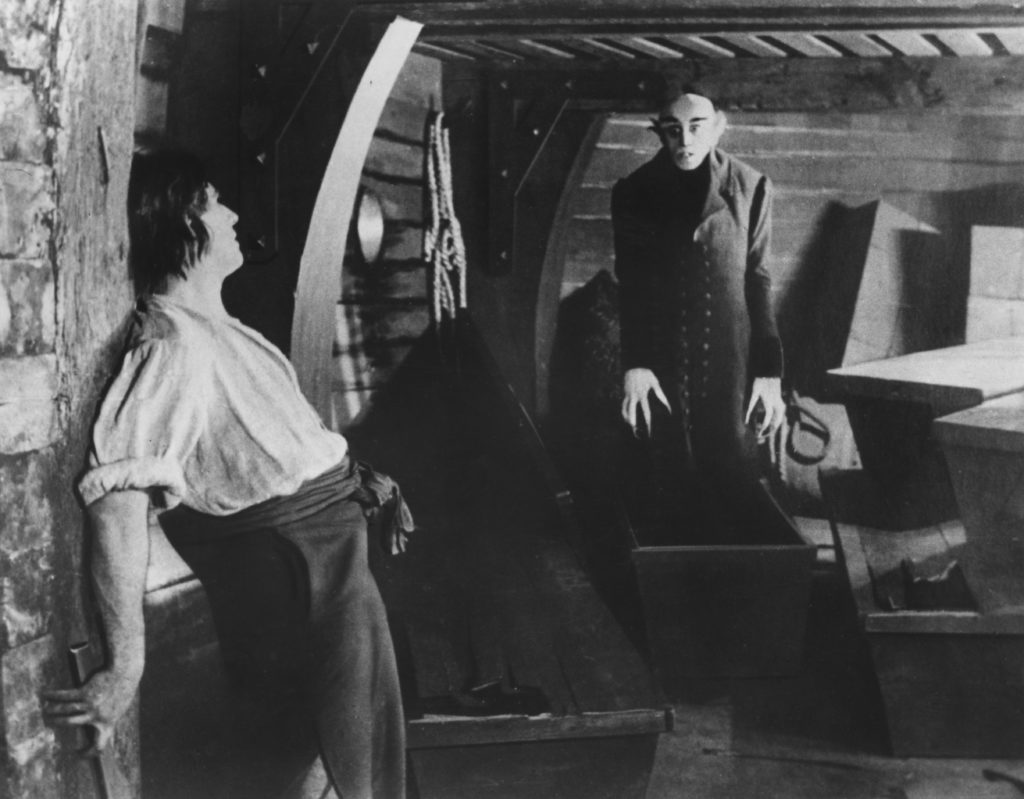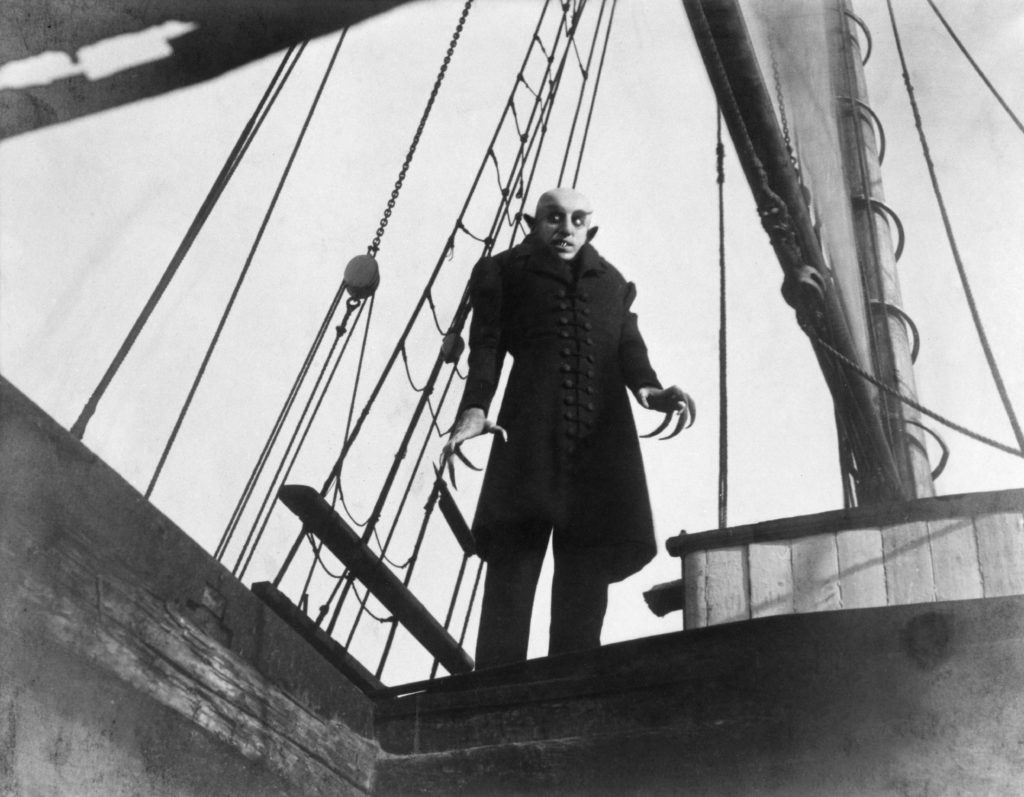This Friday, March 5, marks the 100th anniversary of the German silent horror film Nosferatu. An early example of German Expressionism, the film was directed by F.W. Murnau, who helmed other early cinematic masterpieces such as Sunrise (1927) and City Girl (1930), and starred Max Schreck as a Transylvanian vampire named Count Orlok.
Orlok is looking for new digs, which brings estate agent Thomas Hutter (Gustav von Wangenheim) his way. Hutter has heard stories of the mysterious Orlok, mostly from locals who cower at the mere mention of the Count’s name. Paying no mind, Hutter makes his way to Orlok’s castle and is invited to stay for dinner. Hey, can’t beat a free meal!
While dining, Hutter cuts his thumb with a steak knife and begins to bleed profusely. Like any good host, Orlok offers to suck the blood out. Hutter politely declines the medical help and begs off to bed. In the morning, the agent notices two strange puncture wounds on his neck, but chalks it up to some nasty mosquitoes.
After signing some deeds, Orlok notices a picture of Hutter’s wife, a real dish named Ellen (Greta Schröder). Orlok comments that Ellen has “a nice neck.” Ignoring Orlok’s skeeziness, Hutter stays yet another night in the castle, eventually stumbling upon the coffin in which Orlok takes his rest. “Ah, dude’s a vampire,” Hutter says to himself.
[embedded content][embedded content]
Orlok settles into his pad and sets his sights on obtaining Ellen. Ellen, however, has plans of her own, after reading a book on vampires that states a pure-hearted woman can defeat the blood-suckers with their beauty. Feeling herself, Ellen invites Orlok into her bed through a window, but the Count is too much for her and starts sucking. Unfortunately for Orlok, the window remained open, and with the sun rising, he ended up vanishing in a puff of smoke. Dead as a doornail. Well, at least he didn’t leave in the middle of the night. Hutter rushes in and embraces his wife. Sadly, her fate is sealed and she dies in her husband’s arms. The town then torches Count Orlok’s castle, paving a way for a T-Mobile store in its place.
If any of this sounds familiar, that’s because you’ve either read Bram Stoker’s classic 1897 novel Dracula, or you’ve searched through Ted Cruz’s Pornhub account — Count Cuckula is actually a solid idea for a porn parody (Author’s note: apparently it’s a video game. God, why did I Google this?)
Anyway, Stoker’s estate also found Nosferatu to be quite similar to the book and they sued the shit out of Prana Film, the studio behind the century-turning film. And they won. Every copy of the plagiarized film had to be destroyed. Court orders. But like a vampire, the film was hard to kill. A handful of prints survived, thankfully, and the film, despite its sin of intellectual theft, has endured as a movie classic.
As it should.

Brimming with moody cinematography and a creepy organ accompaniment, the movie is, as its opening title card states, a “symphony of horror.” Even the architecture is creepy. Filmed mostly in the iron and steel port town Wismar in northern Germany, Parna took full advantage of the brick Gothic-style buildings that were erected around the 13th century. Many characters are staged standing in an arched doorway, harsh light cutting across the walls. Film Noir would later owe its whole aesthetic to German Expressionism. As where that distinctly American genre used the contrast of darkness and light to reveal the glumness of post-war society, the Germans were mostly men who created fright.
Towards the end of Act I, when Hutter opens his bedroom door and we glimpse the reveal of Nosferatu in full-on blood-sucker mode, with his railroad spike-length fangs, pointy ears, and his bug eyes staring directly towards us, I must admit, even having seen the film numerous times, and the fact that it was broad daylight outside, it had me shook.
One person that often gets overlooked when discussing this film is producer and production designer Albin Grau. Born in Leipzig-Schönefeld, Germany, in 1884, Grau was a member of the German magical order called Fraternitas Saturni — or Brotherhood of Saturn for you English-speakers. The group, which is still active today, concerns themselves with “the study of esotericism, mysticism, and magic in the cosmic sense.” As opposed to your practical magic.
Grau had wanted to make a vampire movie ever since his service in the German army during World War I. There he met a Serbian farmer who told him that his farmer was a vampire. Being the type to believe such a tall-tale, Grau returned home from war and started Prana Studios, where it was his intention to create multiple movies revolving around occult and paranormal activities. Sadly, we never got to see Prana’s multiverse slate come to fruition. After the Stoker lawsuit, Prana went tits up and Nosferatu ended up being its sole production. By the mid-1930s, any mention of the occult was banned in Nazi Germany. That was enough for Grau to skip town and end up in Switzerland.
One last thing I’d like to touch on, and it’s a bit of a delicate subject, but that would be the allegations of anti-semitism in Nosferatu. For some, they find the physical appearance of Count Orlok to be in line with certain terrible 19th century stereotypical caricatures of Jewish people: hook nose, bald head, rat-like facial tics.

Look, it’s hard to argue against these claims. At one point in the film, Orlok arrives in his new village by ship, joined by a mischief of rats, which then spread plague throughout the town. Not good. To complicate matters, numerous people involved with the film, including its writer, Henrik Galeen, was Jewish. Alexander Granach, who plays the vampire’s right-hand man Knock, was not only Jewish, but had been a superstar of Yiddish theater. Worse still, Hitler made several references to Jews being a “race that shuns the sunlight” in his manifesto Mein Kampf.
While I am still able to enjoy the film, I simply can’t ignore the gross representation on screen. Nor should you. So, do what I do and pair it with a pro-Jewish movie. It’s like the person who eats at Chick-Fil-A who then later donates to an LGBTQ+ charity. So, yeah, pop Yentl or Neil Diamond’s version of The Jazz Singer into the VCR and even Steven. Wait…maybe not the Diamond film.
Filmmaker and avid outdoorsman Werner Herzog later remade Nosferatu in 1979, starring his best fiend Claus Kinski as the titular vamp. Available for free on YouTube, it’s worth checking out. The opening scene shows a collection of skulls and shrunken corpses while a heart beats over the soundtrack. True to Herzog’s insane genius, the journey by foot to the Count’s castle (here known as Count Dracula) is a spectacular set piece. Herzog, one of the leaders of what was then called “The New German Wave” looked back into his homeland’s cinematic origins, crafting perhaps his most accessible film to date, while still maintaining the qualities we’ve come to love from him: hand-held cinematography, perilous locations, and an ever-evolving thesis on masculinity.
Seventy years after Murnau delivered his take on Stoker’s novel, the DIY impresario and wine merchant Francis Ford Coppola released his overstuffed, yet still fascinating, version, starring Gary Oldman as a restless dandy Dracula trying his best to seduce a wide-eyed Winona Ryder. The film was a minor hit.
OK, if you haven’t figured it out by now, I’m a pretty big vampire film freak. To quote Marge Simpson, “I just think they’re neat.” The spooky mansions, the long-draping robes, rock ‘n’ rolling all night and sleeping in every day, what’s not to love?
Here are four other vampire films I highly recommend.
From Dusk Till Dawn (1996)
Hot off his success with Pulp Fiction, Quentin Tarantino writes and co-stars (opposite a badass George Clooney) in this crime/horror hybrid. Easily in my top 10 movie-going experiences, as I was not only there opening night, but, being an expert in all things QT, knew what was in store, unlike 90% of the audience. The moment Salma Hayek goes from babe to blood-sucker, a waft of WTF filled the theater. Heads turned left and right as the movie turned from a bang-bang shoot ‘em up to a bite-bite stake ‘em vampire flick. More movies like this need to exist.
[embedded content][embedded content]
Scream Blacula Scream (1973)
The sequel to the smash ‘70s blaxploitation Blacula, Scream Blacula Scream is a hot mess. The script is confusing, the camera work is shoddy, and the acting is lackluster. But that’s also kind of why I love it. To hammer (Films) my point home, on the syndicated TV program Siskel & Ebert, the critics were split. Ebert gave it a big old thumbs down, while Siskel, thumb pointing up, said it was superior to the original. It’s the kind of movie you and your friends can sit and make fun of, but never get bored with it.
Near Dark (1987)
Directed by Kathryn Bigelow, this movie, about a roaming band of vampires, is 10 times better than The Hurt Locker. Part horror film, part western, Near Dark is a meditation on the suffering of such an existence. It’s a dusty, grimy, low-lit masterpiece that features one hell of a massacre scene, scored by John Parr’s “Naughty Naughty.”
A Girl Walks Home Alone At Night (2014)
Set in the Iranian ghost-town named Bad City, this Persian-language film announced the arrival of writer and director Ana Lily Amirpour. Shot in lush black and white, the film tells the story of star-crossed lovers, working man Arash and a mysterious woman dressed in an all-black candor, who has a penchant for biting necks. The film often evokes the style of the Spaghetti Western made popular in Italy during the 1960s.

Leave a comment